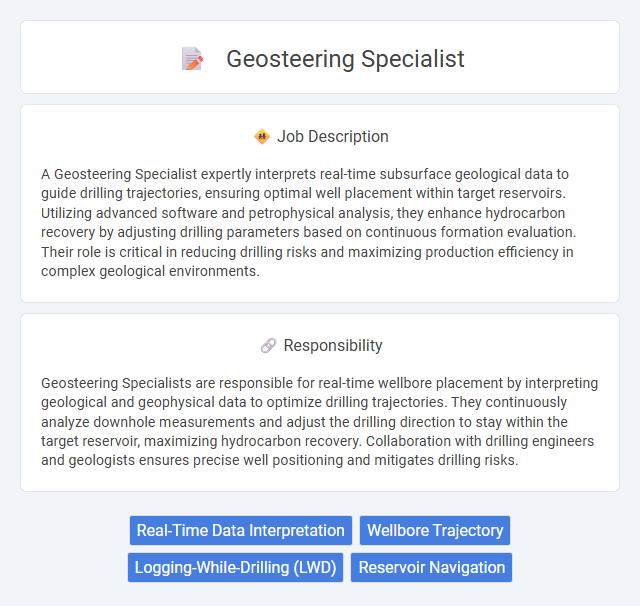
A Geosteering Specialist expertly interprets real-time subsurface geological data to guide drilling trajectories, ensuring optimal well placement within target reservoirs. Utilizing advanced software and petrophysical analysis, they enhance hydrocarbon recovery by adjusting drilling parameters based on continuous formation evaluation. Their role is critical in reducing drilling risks and maximizing production efficiency in complex geological environments.
People who enjoy analyzing real-time geological data and making quick decisions under pressure are likely to be well-suited for a Geosteering Specialist role. Those with strong problem-solving skills, attention to detail, and a passion for technology may find this job particularly rewarding. Individuals who prefer routine tasks or minimal teamwork might face challenges adapting to the dynamic and collaborative nature of geosteering work.
Qualification
A Geosteering Specialist requires a strong background in geology, petroleum engineering, or geosciences, typically supported by a bachelor's or master's degree. Proficiency in interpreting real-time geophysical data and advanced software such as Interactive Petrophysics (IP) and Wellsite Geosteering Systems is essential. Experience with directional drilling operations and well placement optimization is highly valued, alongside strong analytical and problem-solving skills.
Responsibility
Geosteering Specialists are responsible for real-time wellbore placement by interpreting geological and geophysical data to optimize drilling trajectories. They continuously analyze downhole measurements and adjust the drilling direction to stay within the target reservoir, maximizing hydrocarbon recovery. Collaboration with drilling engineers and geologists ensures precise well positioning and mitigates drilling risks.
Benefit
A Geosteering Specialist likely enhances drilling accuracy by interpreting real-time geological data, which can reduce well placement risks and minimize costly errors. This precision may lead to improved hydrocarbon recovery rates and increased operational efficiency, potentially lowering overall project expenses. Employers could benefit from faster decision-making processes and optimized resource allocation through the specialist's expertise.
Challenge
The Geosteering Specialist role likely involves navigating complex subsurface formations while continuously adjusting drilling trajectories to maximize resource extraction. Professionals in this position probably face challenges related to interpreting real-time geological data and making rapid decisions under uncertain conditions. Success in this field may depend on strong technical expertise and the ability to adapt to evolving geological discoveries during drilling operations.
Career Advancement
Geosteering Specialists use real-time geological data to optimize well placement, significantly impacting hydrocarbon extraction efficiency. Expertise in advanced geosteering software and subsurface interpretation techniques accelerates career progression into senior technical roles or management positions within oil and gas companies. Continuous skill development in directional drilling technologies and reservoir characterization enhances opportunities for leadership and specialized consulting roles.
Key Terms
Real-Time Data Interpretation
A Geosteering Specialist leverages real-time data interpretation to precisely guide drilling operations within the targeted geological formations, ensuring optimal well placement and maximizing hydrocarbon recovery. Utilizing advanced software and geophysical measurements, they continuously analyze subsurface data such as gamma ray, resistivity, and density logs to make immediate adjustments during drilling. Expertise in integrating petrophysical and geological information helps minimize drilling risks and reduces non-productive time by maintaining the drill bit within the desired reservoir zones.
Wellbore Trajectory
A Geosteering Specialist plays a crucial role in optimizing wellbore trajectory by integrating real-time geological data and directional drilling information to maintain the wellbore within the targeted reservoir zone. They utilize advanced software and geophysical measurements to make precise adjustments during drilling, enhancing hydrocarbon recovery and reducing drilling risks. Expertise in interpreting measurement-while-drilling (MWD) and logging-while-drilling (LWD) data ensures well placement accuracy aligned with geological models.
Logging-While-Drilling (LWD)
A Geosteering Specialist specializing in Logging-While-Drilling (LWD) utilizes real-time geological data to optimize well placement and maximize reservoir contact during drilling operations. Expertise in interpreting LWD logs such as gamma ray, resistivity, and azimuthal measurements helps guide directional decisions to stay within target zones and avoid hazards. Proficiency in advanced software tools for data analysis and collaboration with drilling engineers ensures efficient, cost-effective hydrocarbon extraction.
Reservoir Navigation
A Geosteering Specialist plays a critical role in reservoir navigation by utilizing real-time geological and drilling data to guide well placement within targeted hydrocarbon zones. Expertise in interpreting directional drilling indicators and petrophysical logs ensures optimal well trajectory, enhancing reservoir exposure and maximizing hydrocarbon recovery. Advanced software tools and seismic interpretation techniques are integral to continuous adjustments in drilling paths that prevent reservoir breaches and reduce non-productive time.
 kuljobs.com
kuljobs.com